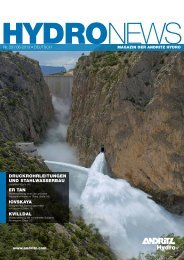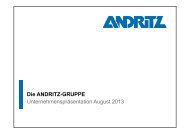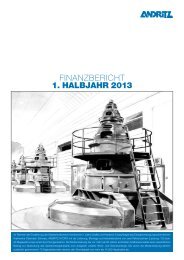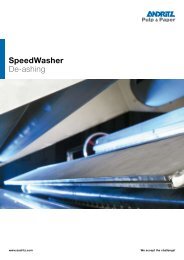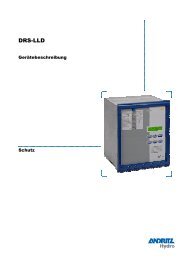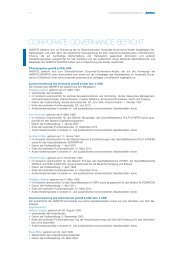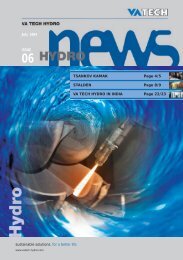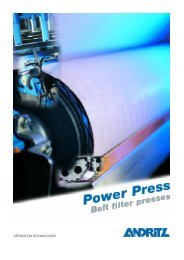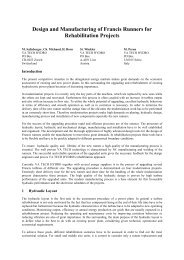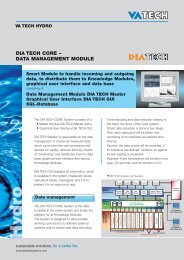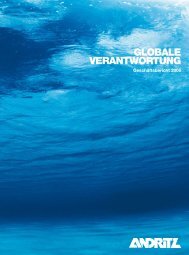FiberSpectrum - ANDRITZ Vertical volute pumps
FiberSpectrum - ANDRITZ Vertical volute pumps
FiberSpectrum - ANDRITZ Vertical volute pumps
You also want an ePaper? Increase the reach of your titles
YUMPU automatically turns print PDFs into web optimized ePapers that Google loves.
CMPC Celulosa<br />
“Working with what nature puts<br />
at our door.”<br />
The timing could not have been better – or worse. In a market sense, this was the perfect time to start up an<br />
800,000 t/a bleached eucalyptus market pulp line. From a social perspective, however, this start-up was in the<br />
white-hot spotlight of public scrutiny after two other Chilean projects had environmental mishaps. All eyes were on<br />
CMPC, its suppliers, and construction partners to see if the “Santa Fe 2” project could live up to its promises.<br />
▼ Eugenio Grohnert, CMPC’s Project Director:<br />
“I am most impressed with how Andritz responds.<br />
They know their business and are able to support<br />
their clients when there is a problem.”<br />
“That we could construct this mill<br />
without any safety or environmental<br />
problems, start it up and bring it to full<br />
production in world-record time, and<br />
operate it today with complete transparency<br />
for the authorities and our customers,<br />
is a grand tribute to all involved,”<br />
says Sergio Colvin, Managing Director<br />
of CMPC Celulosa.<br />
Now that the intensity of the time has<br />
subsided, and Santa Fe’s Line 2 has<br />
been producing on-grade pulp since the<br />
time it started up (03:15 on December 9,<br />
2006 to be exact), Colvin can focus on<br />
CMPC’s next move.<br />
A distinguished man of 60, Colvin is<br />
a gracious host in his Santiago office,<br />
offering coffee and patiently answering<br />
all questions. While the discussion<br />
focuses on the Santa Fe mill and<br />
Line 2, it is intriguing to understand<br />
the background and events leading to<br />
this Chilean producer’s largest capital<br />
investment.<br />
A proudly private enterprise<br />
Since its founding in 1920, Compania<br />
Manufacturera de Papeles y Cartones<br />
(CMPC) has always been a privately<br />
capitalized company in Chile – even<br />
during the challenging political periods<br />
in the nation’s history. Today, it has<br />
about 7500 shareholders, with the majority<br />
shares being held by the founding<br />
Matte family.<br />
“Without dwelling on the politics, let’s<br />
just say Chile was in a period of political<br />
and economic crisis at the time when<br />
I joined (1978),” Colvin says. “CMPC<br />
was in survival mode and was looking<br />
for Chileans with a university degree<br />
| <strong>FiberSpectrum</strong> 16 – 02/2007<br />
who had some experience outside of<br />
Chile.”<br />
Colvin’s first task at CMPC was to help<br />
them create a network oriented to the<br />
export business that would make them<br />
a world-class exporter of specialized<br />
products. Colvin was instrumental in<br />
rationalizing the export product line, establishing<br />
the contacts, negotiating with<br />
international customers, and creating a<br />
profitable export business.<br />
Today, CMPC is an integrated producer<br />
of pulp, paper, and other forest products.<br />
There are five subsidiaries: Forestal<br />
Mininco (forestry and solid wood), Celulosa<br />
(pulp), Papeles (paper), Tissue, and<br />
Productos de Papel (paper products).<br />
Total sales in 2006 were US$ 2.3 billion.<br />
CMPC Celulosa represents about<br />
34% of total sales and 55% of the total<br />
EBITDA. There are three kraft pulp<br />
mills in Chile: Pacifico, Laja, and Santa<br />
Fe. “Our net pulp production reached<br />
a total of 1.2 million tonnes in 2006,<br />
a similar volume to the year before,”<br />
Colvin says. “This, despite the normal<br />
disruptions caused by the major<br />
construction projects at Laja and Santa<br />
Fe.” Total production for 2007 will approach<br />
two million tonnes.<br />
CMPC has one of the most competitive<br />
cost structures in the global pulp<br />
industry. It has boosted this comparative<br />
advantage by the genetic selection<br />
of more robust and high-yielding trees.<br />
Add to this the CMPC investments in<br />
advanced technology. CMPC is the<br />
only forest products company in the<br />
world to hold an A-rating by Fitch and<br />
Standard & Poors. It has a strong balance<br />
sheet prepared for growth opportunities<br />
and is expert at managing risk.<br />
▲ The twin wire dewatering machine at CMPC. The addition of the shoe press helped Santa Fe overcome<br />
the poor drainage characteristics of the eucalyptus nitens, which comprise 70% of the furnish for Line 2.<br />
▼ Eucalyptus brownstock contains a high level of hexenuronic acids which consume chlorine dioxide in<br />
the bleach plant. Andritz’s patented A-Stage in the first bleaching stage reduces bleaching chemical<br />
consumption. There is also a large degree of filtrate recirculation in the bleach plant to minimize the<br />
effluent being discharged.<br />
4 5



